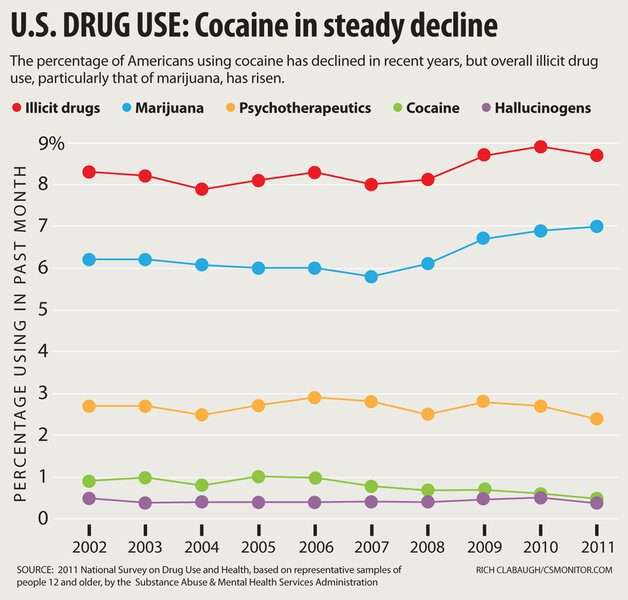Cocaine use: Will the factors behind its steady decline continue?
Loading...
Cocaine use and a host of problems associated with the drug have been declining steadily in the United States in recent years – with at least a 40 percent drop in people using cocaine since 2006.
“I’ve never seen such a rapid decline for such an addictive drug,” says Peter Reuter, a public-policy professor and drug-economy expert at the University of Maryland in College Park.
Some supply-side factors, as well as demand-side issues, have contributed to the downward trend, according to medical, academic, and drug-policy experts.
A US-Colombian partnership has contributed to a 44 percent drop in the capacity for pure cocaine production in the Andean region since 2001, according to July’s annual estimate by the White House’s Office of National Drug Control Policy (ONDCP). In addition, interceptions along trafficking routes by the Coast Guard and Defense Department have decreased the amount of cocaine entering the country, the ONDCP reports.
Still, opinions vary when it comes to interpreting the overall cocaine trend and the possible reasons for it. How much is there to celebrate, some ask, given the broader context of illicit drug use in the US – which has risen slightly in recent years, largely because of a rise in the use of marijuana (see accompanying chart).
The 2011 National Survey on Drug Use and Health, which is based on representative samples of people 12 and older, gives some indicators of cocaine’s decline:
• In 2011, there were 1.4 million cocaine users, about 0.5 percent of the population – down from 2.4 million (1 percent) in 2006.
• The number who first tried cocaine in the prior year dropped from 1 million in 2002 to 670,000 in 2011.
• The number who abused or were dependent on cocaine declined from 1.7 million in 2006 to 0.8 million in 2011.
The ONDCP also noted these encouraging national statistics in releasing its annual estimate this month:
• A 65 percent drop in the rate of people testing positive for cocaine in the workplace (from 72 out of every 10,000 tested in 2006 to 25 in 2012).
• A 44 percent drop in overdose deaths related to cocaine (from 7,448 in 2006 to 4,183 in 2010).
The National Survey on Drug Use and Health, several experts note, is based on interviews and therefore may understate usage levels. It also doesn’t capture data from homeless or incarcerated people.
However, data collected by ONDCP for the Arrestee Drug Abuse Monitoring program show a significant decline in the percentage of male arrestees found to have cocaine in their systems through drug tests. For instance, half of the arrestees in Chicago had taken cocaine in 2000, but only 19 percent had done so in 2012.
At a recent meeting of epidemiologists who track drug trends in 21 regions across the US for the National Institute on Drug Abuse (NIDA), “most agreed cocaine use is down,” along with related issues such as deaths and addictions, says Jane Maxwell, a senior research scientist at the School of Social Work at the University of Texas, Austin. “But the bottom line is, people are still being hurt by cocaine.”
Some experts attribute the recent drop in US consumption largely to rising prices and shifts in the market (with an increasing share of cocaine going to Europe and emerging markets around the globe). In January 2007, the average price per pure gram was $98; between 2008 and 2012, it ranged from $175 to $195, according to national Drug Enforcement Administration data reported by Ms. Maxwell.
Higher prices, combined with a decline in purity of the cocaine available in the US (which leads to less-intense effects), have led many cocaine users to shift to other drugs, Maxwell says. In Texas, for instance, it appears some are turning to methamphetamines coming out of Mexico. Maxwell also worries there will be more injuries related to cocaine users injecting “bath salts,” a new wave of synthetic drugs, to intensify their highs.
Another line of explanation is that drugs go in and out of style over the years and “it probably has very little to do with successes or failures with interdiction and source control,” says Ethan Nadelmann, executive director of the Drug Policy Alliance in New York City, which advocates reforming drug-control policies.
After the peak of the crack cocaine crisis in the early 1990s, crack became “uncool” even among drug users, Mr. Nadelmann says. Anecdotally, he’s heard recently that cocaine is regaining popularity in artsy crowds.
As the economy rebounds, more Americans may turn again to cocaine, often considered “the champagne of street drugs,” says James Hall, an epidemiologist at the Center for Applied Research on Substance Use and Health Disparities at Nova Southeastern University in Davie, Fla., and a member of the NIDA tracking group.
Unlike most other regions, southern Florida has seen cocaine-related emergency-room visits rise sharply in the past several years – perhaps an indicator that cocaine will soon be on the rise again nationwide, Mr. Hall says. In the 1970s, Miami was a harbinger of the original cocaine epidemic.
Despite a decline in cocaine use, there’s a great deal of cause for concern about other trends in drug use, Hall and others say.
“What has emerged in prescription drug abuse, particularly prescription opioids, is the most dangerous, the most addictive, and the most deadly drug problem of our lifetime,” Hall says. Even though the number of illegal prescription drug users has declined in the past few years, he says, the problems are severe.
Whatever the drug, “the real front line in these epidemics is treatment,” Hall says.
In his budget request for fiscal year 2014, President Obama asked for $1.4 billion more for treatment than was enacted in FY 2012. It’s the largest requested increase in at least two decades, says Rafael Lemaitre, ONDCP spokesman.
Overall progress in the fight against drugs is visible, Mr. Lemaitre says, if one looks back to the peak of 1979, when roughly 14 percent of Americans reported using illicit drugs. The survey methodologies have changed slightly since then, so it is difficult to compare numbers precisely, but today, the figure is just under 9 percent.







